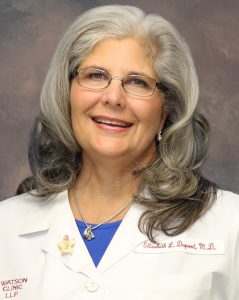
Dr. Elisabeth Dupont
Lakeland Surgical & Diagnostic Center (LSDC) is one location for a national study that is exploring ways to reduce the number of operations for breast cancer patients. Dr. Elisabeth Dupont, of Watson Clinic, is among a dozen doctors participating in the study. She is performing them mostly at LSDC, with a few at Lakeland Regional Health.
When patients undergo a partial mastectomy, or lumpectomy, surgeons routinely take tissue, called “margins,” around the lesion in an attempt to ensure that all of the cancer was removed. The goal is to have a “negative,” or clear margin, which indicates the cancer in that area was removed completely. In an astonishing 20 percent to 40 percent of cases nationwide, patients have to return for a second margin before getting a clear result, and a significant number must have a third.
“The problem is in breast surgery you can’t always see or feel the cancer,” says Dr. Dupont. “Cancer that is inside a milk duct, for instance, you don’t always know if it’s there. There is no good way of knowing whether you have achieved a negative (or clear) margin until the final pathology comes back. No one wants to come back, but for some patients, it’s a very big deal. It’s very risky to undergo a second surgery.
“And so this study is asking, is there something we can do to optimize that so that the number of patients who have to come back is reduced?”
The study, which originated with Dr. Anees B. Chagpar at Yale University’s School of Medicine, is now in its second stage. The study is a multi-site, randomized trial that considers routinely taking extra margins. In this study, a surgeon removes the lesion, then any extra margins per the usual routine. Then Yale is contacted, and the patient is randomized to finishing the procedure as it stands or taking out a second margin in hopes of reducing the number of positive margins and therefore, the number of patients who will have to undergo more surgery.
Dr. Dupont says she does not know what the study will conclude. However, she noted that in the first stage of the study — which was reported in the New England Journal of Medicine (Aug. 6, 2015) — in the cases in which Dr. Chagpar and three colleagues at Yale Cancer Center took additional margins, the number of patients who had to return for a second margin was reduced by almost half.
So why wouldn’t surgeons routinely take greater margins? Surgeons must weigh the benefit of an extra margin preventing a second operation versus a possible less-than-optimal cosmetic result, especially in women with smaller breasts.
The study will be ongoing until data has been collected on 400 patients, probably about a year. Dr. Dupont expects to contribute 50 patients’ results, and she will follow them to track recurrence risks and whether one group does better in the long-term than the other.
“I’m so pleased LSDC is taking the charge with us,” Dr. Dupont says. “They’ve been wonderful to work with, and I appreciate them so much.”

